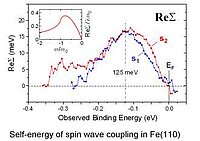Coupling of Electrons to Magnetic Order and Spin Waves
Magnetic order in bulk condensed matter and at surfaces has a significant influence on the electronic states. An impressive example is the energy gap in the antiferromagnet chromium, which we have detected spectroscopically. It results from its spin density wave, which even at room temperature is strongly pronounced near the surface.
Yet even irrespective of such superstructures, all metallic electron states are subject to interaction with collective magnetic excitations, typically spin waves. This should consequently lead to a mass enhancement in analogy to electron-phonon coupling, albeit at a different energy scale characteristic of spin waves. The prominent importance of this magnetic interaction results from the connection to high-temperature superconductivity, where such a coupling mechanism is discussed as the origin of pair formation. In studying surface states on Fe(110), we succeeded to demonstrate that significant coupling occurs on the spin wave energy scale. Further investigations including antiferromagnets are currently underway. Using ARPES, one may observe the simultaneous existence of so-called “kinks“ in the band structure due to electron-phonon as well as electron-spin wave interaction.


